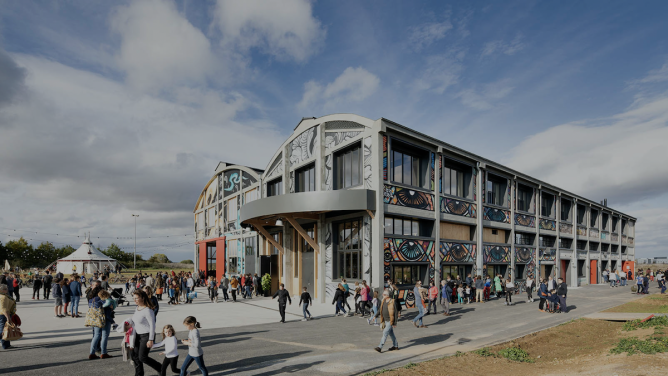Based on the principle that resources are limited, the concept of circular economy consists of achieving sustainability, by limiting the production of waste and wastage. It is not just a matter of recycling, but a complete overhaul of the production cycle. That means moving away from the current linear model, to implement systems that minimise the use of non-renewable resources and favour closed cycles, in which material and energy flows from one part of the production system feed into its other components.
The circular economy is both a new economic perspective and a response to the climate crisis for the construction industry, whose environmental impact remains very high. In France alone, the sector generates around 46 million tonnes of waste annually.
Globally, construction accounts for 11% of CO2 emissions, a figure that rises to 39% with the energy consumption of buildings. To meet the target set by the Paris Climate Agreement, emissions from the construction industry must be halved by 2030, and drop to zero by 2050.
What the Agec 2020 law provides for
In France, the Agec law [Anti-waste law for a circular economy] 2020, whose measures must come into force by January 2022, is adding its own priorities to the objectives. In addition to the Extended Producer Responsibility, it requires the construction industry to draw up an action, prevention and eco-design plan every five years, to reduce the use of non-renewable resources and increase the use of recycled materials.
Construction professionals will be required to carry out a Products Equipment Materials Waste (PEMD) diagnosis before starting any deconstruction work over 1,000 m², as well as for other major renovations. Finally, illegal construction waste dumping will incur heavier penalties.
In France, the Bâtiment-Énergie Fundation, funded by Ademe and the Centre Scientifique et Technique du Bâtiment (CSTB), supports innovative solutions to reduce energy consumption and greenhouse gas emissions and backs the use of renewable energy in the building sector by a factor of four by 2050.
The private sector is mobilising
Whilst the circular economy is a matter of public policies, it is also gaining ground in private construction companies, where recent technological innovations are transforming their ambitions into action. Founded in 2017, startup Altaroad has developed TopTrack system, which uses artificial intelligence to perform the innovative weighing of construction trucks.
A sensor system linked to a machine learning platform provides real-time information on the weight of the load as it leaves the site, as well as locating the waste transported. It also anticipates recovery, optimises the loading and the flow of vehicles on the road. A pilot project was set up with VINCI in 2018.
Granulat+, a subsidiary of the public construction company Eurovia, specialises in the circular economy of materials. It currently has 130 platforms in France, focused on the recycling of public construction waste from road deconstruction. Waste Marketplace offers construction professionals eco-responsible solutions for collecting and depositing construction waste to waste collection centres and recycling centres. And the Finnish start-up Betolar provides ecological alternatives to concrete, which reduces carbon emissions by 80%.
The Netherlands, champions of the circular economy in construction?
The Netherlands have become a model for circular economy projects. “Cities like Rotterdam and Amsterdam are crucibles of renewed architecture, and take account of global health issues,” says Patrick Rubin, the head of Canal architecture consultancy. The Dutch government intends to implement a circular economy in all areas by 2050, including in construction. Among other things, it calls for any government building constructed after 2018 to be energy-neutral by law and aims to reduce the materials used in construction by half by 2035.
Thanks to startup Madaster, a giant register using BIM data to list the characteristics and value of materials used in the construction of existing buildings is also being set up in the Netherlands. It aims to provide buildings with digital passports, to facilitate the reuse of materials at the end of the buildings’ lives, and reduce the raw materials used.
In addition, the Dutch government has introduced financial incentives for the building industry to submit data on new construction projects.
The greenest building in the world
The city of Amsterdam boasts the world’s most circular building, according to the British agency BREEAM, which gave it a sustainability score of 98.4%, the highest ever awarded. Called The Edge and with 40,000 m2 of floor space, this professional building, which houses Deloitte’s offices, produces 10% more energy than it uses, while 28,000 different sensors optimise heating, lighting and ventilation for the occupants’ needs, to limit as much waste as possible.
Amsterdam has also endorsed the City Circle Scan initiative, which scans the entire city to identify areas where the circular economy would best be developed. Among other things, it has concluded that the reuse of building materials could eliminate 900,000 tonnes of waste a year and save the construction sector €85 million a year.
The circular economy as a source of viable business models still needs more evidence. This means exploring new financing models and setting up new links between private and public partners. If the circular economy is to become an achievable perspective, the methods and systems to turn the linear economy into a circular one require further work.
Copyrights: La Grande Halle par Encore Heureux Architectes – 2019


